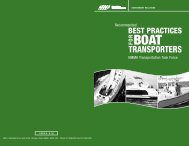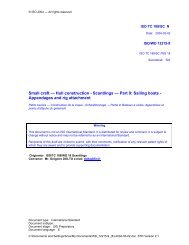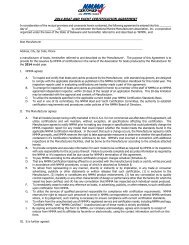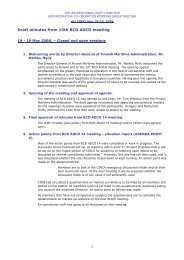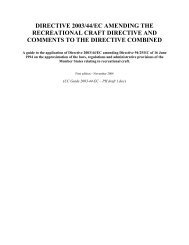global environmental legislation guide - National Marine ...
global environmental legislation guide - National Marine ...
global environmental legislation guide - National Marine ...
Create successful ePaper yourself
Turn your PDF publications into a flip-book with our unique Google optimized e-Paper software.
IMO/MEP share the view that underwater noise, in particular background ambient noisecaused by human activities, is a serious concern. It is particularly an issue for marinemammals but also for other species including fish. Although there is still considerableuncertainty about the relationship between noise levels and their effects, there is growingevidence of the adverse effects of human noise on marine life. It is inevitable that increasingbackground ambient noise levels sooner or later will have serious consequences.A team of scientists specialises in marine mammal research using acoustic methods. Thisresearch has included the development of acoustic equipment and techniques to studywhales from different vessels. The studies also include measurements of noise levels fromships and other sources. The design of the new purpose-built IFAW research vessel “Song ofthe whale” incorporated many measures to reduce noise output from the vessel; includingpropeller design, engine mountings and exhaust and transmission systems.Some factors to considerThere are a large number of design, maintenance and operational factors that influence thenoise levels from vessels. These include speed, loaded displacement, effects of wind andwaves, fouling or propeller damage. Although measurements of noise output exist for manyvessels, they are generally not available across the full range of operating conditions. Noiselevel measurements that are available demonstrate a high level of variability betweenvessels of similar type. Understanding this variability and the factors that contribute to noiseoutput from commercial ships is an important step towards developing mitigation measuresto reduce underwater noise. The report of a correspondence group (MEPC) has noted thatpropellers are the main sources of ship-generated underwater noise and that issues such as"propulsion", “hull design", "on board machinery" and "operational modifications" relate toship design and equipment (as mentioned above).2. EU:MSFD Introduction:The MSFD (Maritime Strategy Framework Directive) requires member states (MS) to worktowards Good Environmental Status (GES) in 2020. Descriptor 11 of the MSDF requiresunderwater noise to be regulated so it does not adversely affect the marine environment.The commission decided on two indicators for underwater noise on 1 September 2010.There was a general agreement within member states and stakeholders such as thenavigation task force group (represented by ICOMIA and ESPO/Rotterdam) that furtherinformation was needed to understand how to use and interpret these indicators. The ECdecided that a technical subgroup on noise (and litter) should address the issue. TheNetherlands and United Kingdom have agreed to co-chair the TSG noise. The marinedirectors meeting in December 2010 approved the terms of reference of the TSG noise. TheTSG noise is foreseen to run until the end of 2011 under its current terms of reference.Defining Good Environmental Status remains the responsibility of member states and is nota responsibility of TSG Noise. The TSG can, however, share ideas on best practices anddevelopments on GES.43



